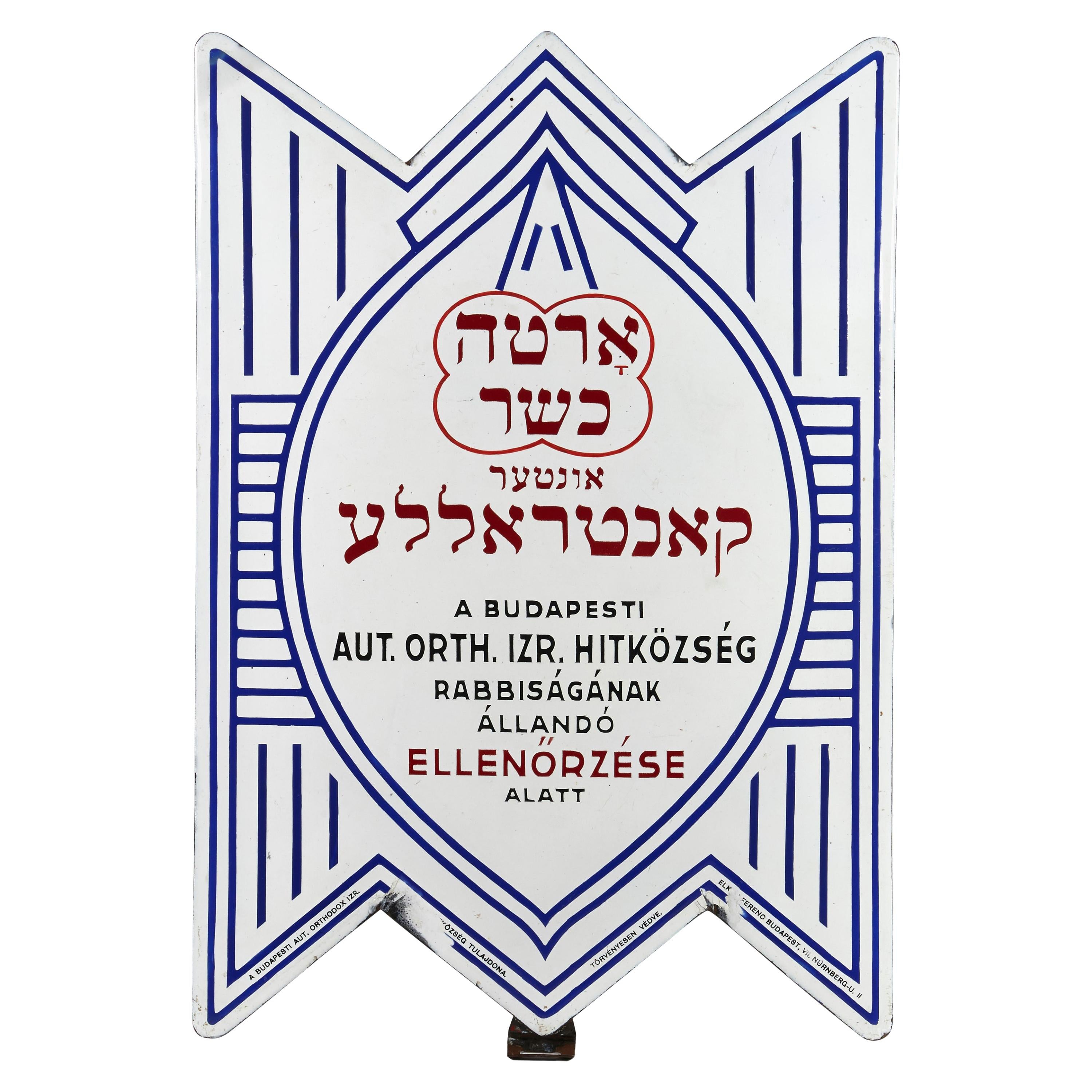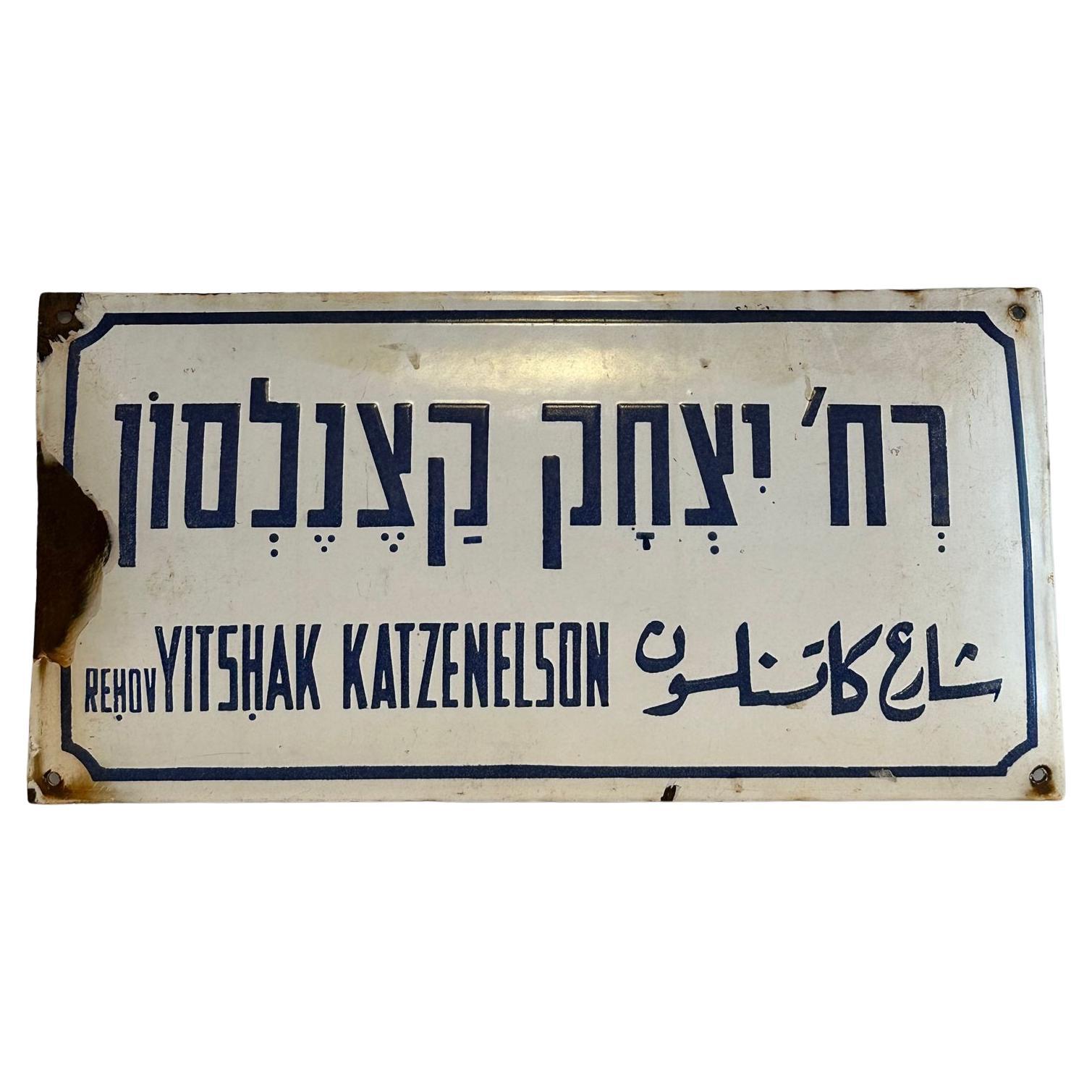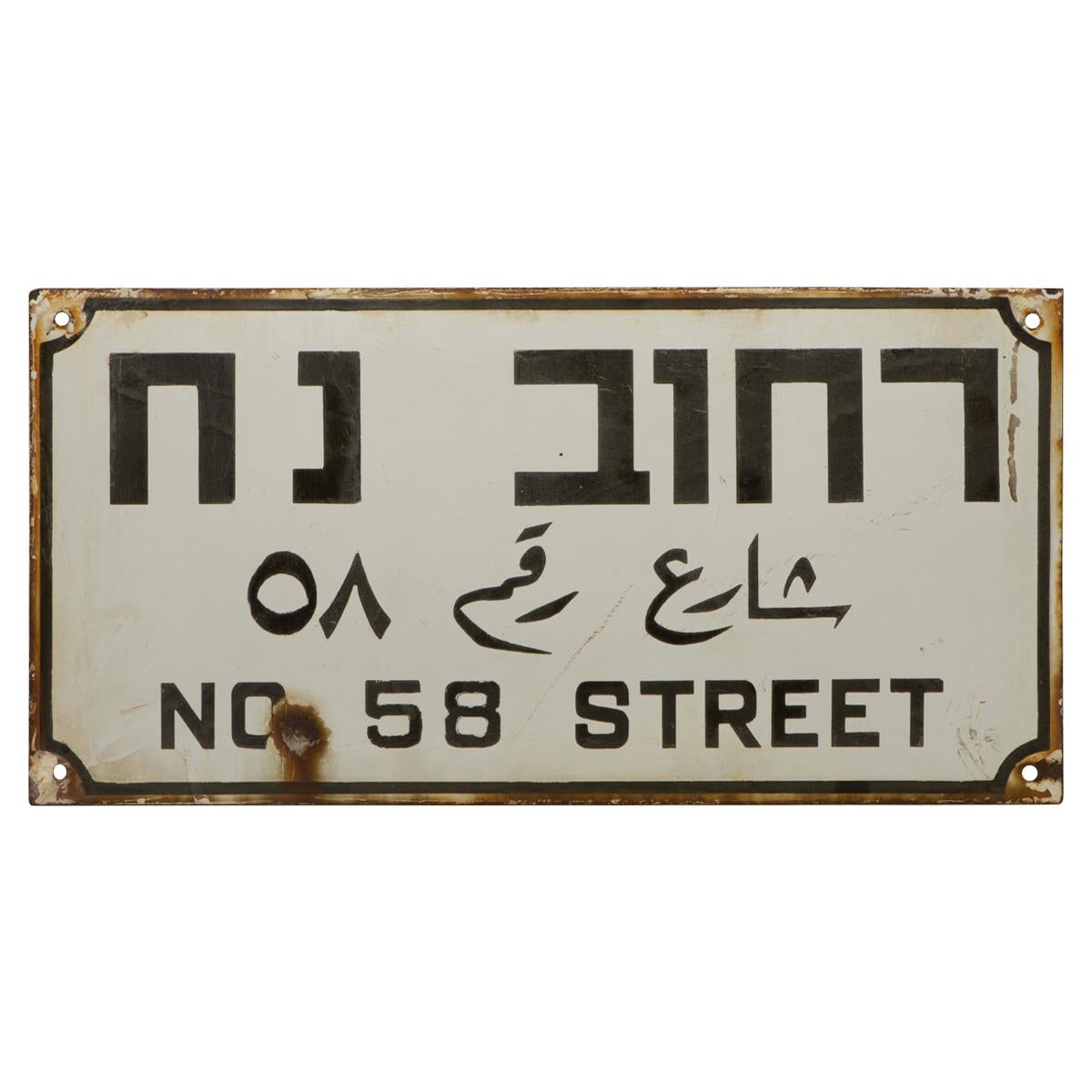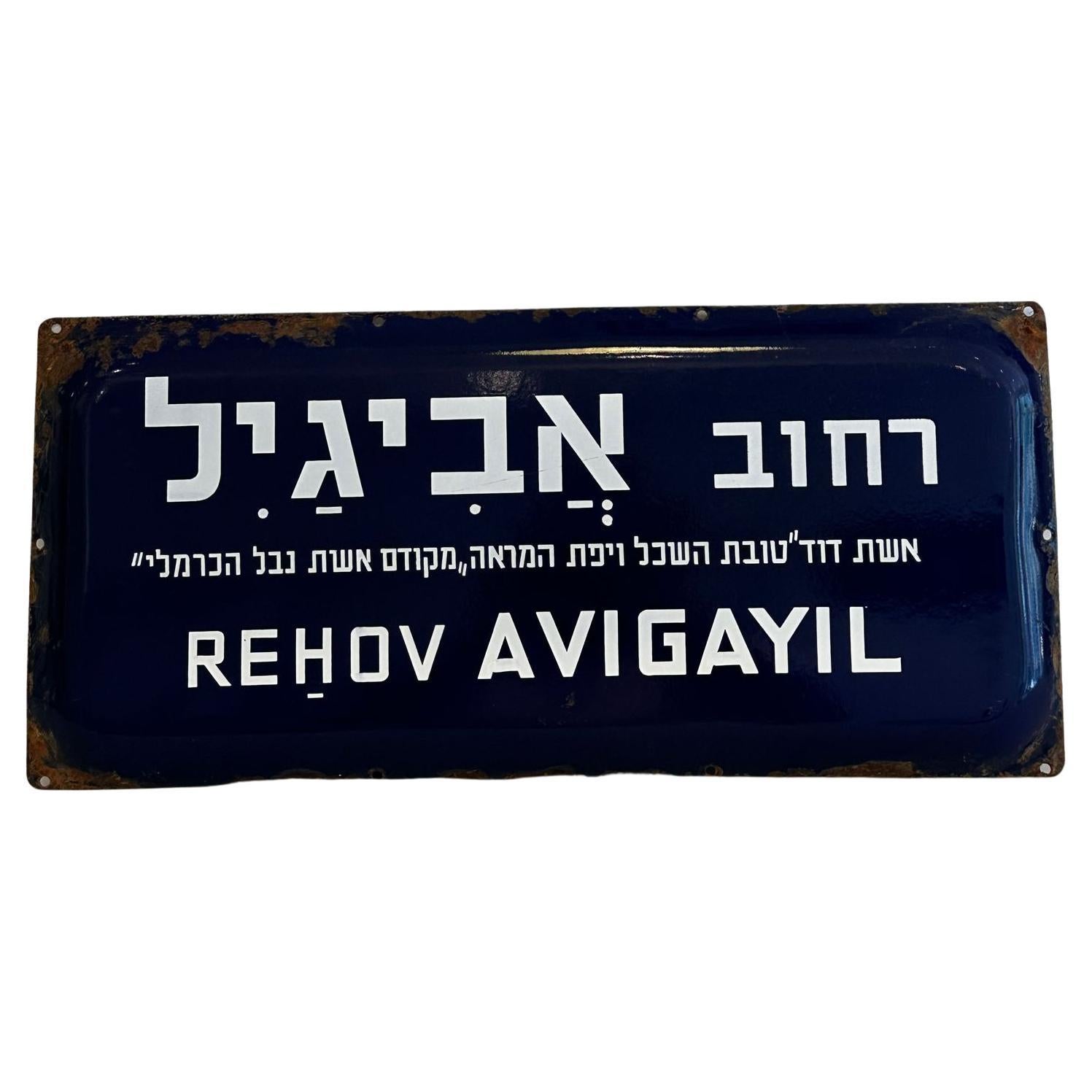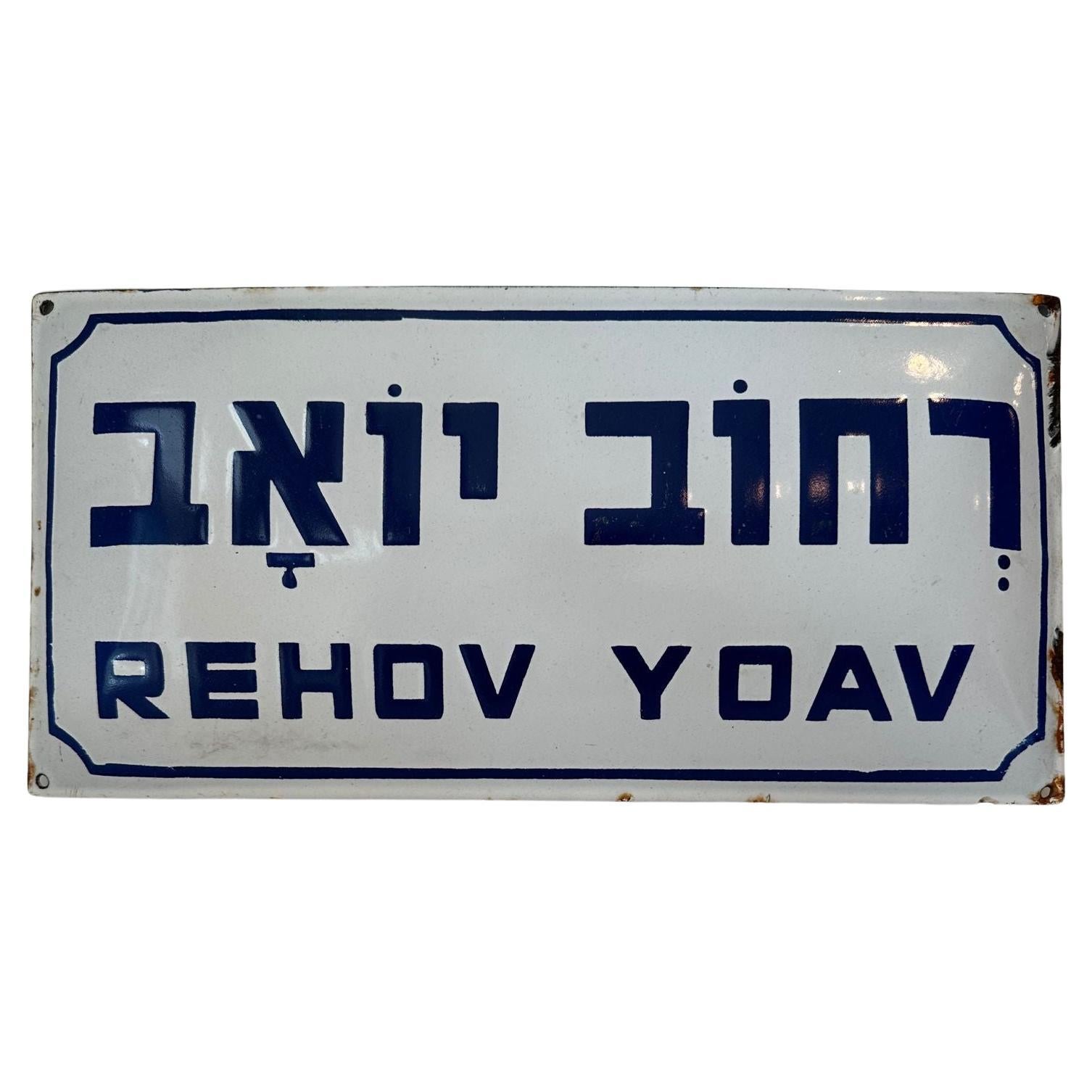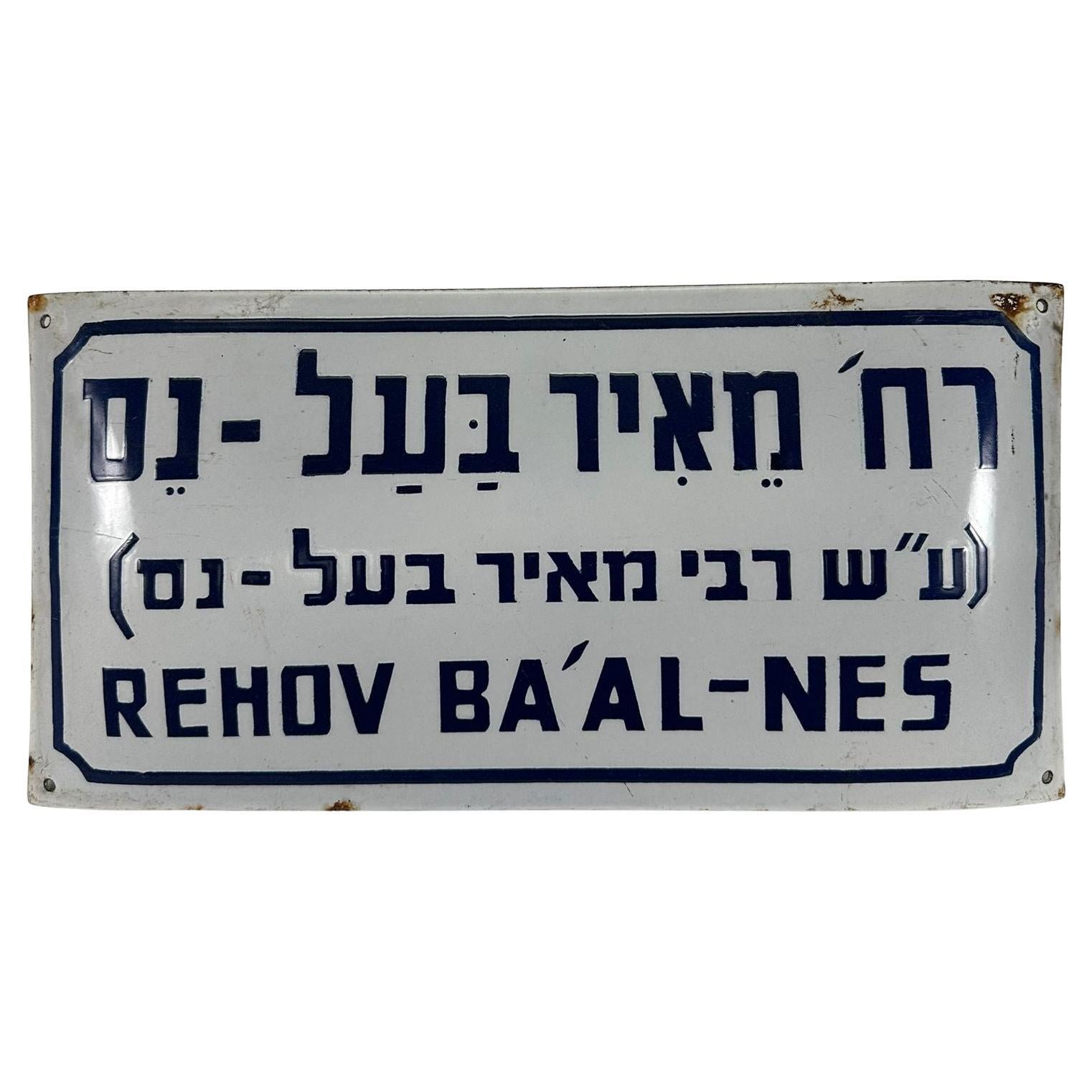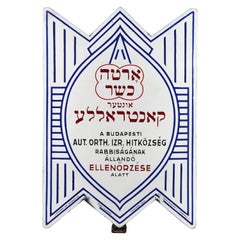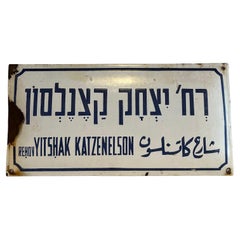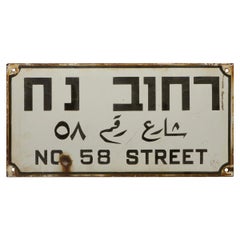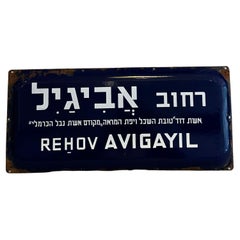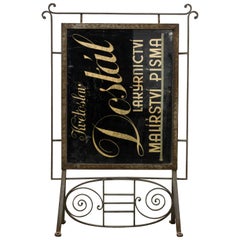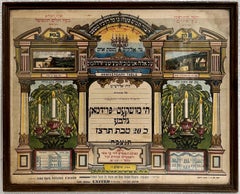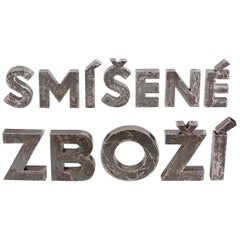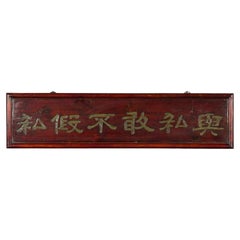Items Similar to Early 20th Century Hungarian Enamel Kosher Butcher Shop Sign
Want more images or videos?
Request additional images or videos from the seller
1 of 8
Early 20th Century Hungarian Enamel Kosher Butcher Shop Sign
$6,338
$9,75034% Off
£4,752.21
£7,310.5234% Off
€5,509.49
€8,475.4734% Off
CA$8,845.01
CA$13,606.6434% Off
A$9,879.07
A$15,197.3734% Off
CHF 5,133.47
CHF 7,897.0234% Off
MX$120,307.21
MX$185,073.4234% Off
NOK 65,206.48
NOK 100,309.7634% Off
SEK 61,443.30
SEK 94,520.7034% Off
DKK 41,107.47
DKK 63,237.2734% Off
Shipping
Retrieving quote...The 1stDibs Promise:
Authenticity Guarantee,
Money-Back Guarantee,
24-Hour Cancellation
About the Item
Heavy and massive enamel Kosher butcher shop sign, Budapest, Hungary, circa 1900.
White and black enamel over iron, inscribed in Hebrew and in Hungarian: "Under the supervision of the Budapest Jewish community Rabbinate".
- Dimensions:Height: 23.63 in (60 cm)Width: 15.75 in (40 cm)Depth: 0.79 in (2 cm)
- Materials and Techniques:
- Place of Origin:
- Period:
- Date of Manufacture:circa 1900
- Condition:Wear consistent with age and use.
- Seller Location:New York, NY
- Reference Number:1stDibs: LU5281219345241
About the Seller
5.0
Recognized Seller
These prestigious sellers are industry leaders and represent the highest echelon for item quality and design.
Established in 2006
1stDibs seller since 2020
130 sales on 1stDibs
Typical response time: 1 to 2 days
- ShippingRetrieving quote...Shipping from: New York, NY
- Return Policy
Authenticity Guarantee
In the unlikely event there’s an issue with an item’s authenticity, contact us within 1 year for a full refund. DetailsMoney-Back Guarantee
If your item is not as described, is damaged in transit, or does not arrive, contact us within 7 days for a full refund. Details24-Hour Cancellation
You have a 24-hour grace period in which to reconsider your purchase, with no questions asked.Vetted Professional Sellers
Our world-class sellers must adhere to strict standards for service and quality, maintaining the integrity of our listings.Price-Match Guarantee
If you find that a seller listed the same item for a lower price elsewhere, we’ll match it.Trusted Global Delivery
Our best-in-class carrier network provides specialized shipping options worldwide, including custom delivery.More From This Seller
View AllEarly 20th Century Hungarian Enamel Kosher Butcher Shop Sign
Located in New York, NY
Heavy and massive enamel Kosher butcher shop sign, Budapest, Hungary, circa 1920.
White, blue, and red enamel over iron, inscribed in the middle :"Or...
Category
Early 20th Century Hungarian Art Deco Architectural Elements
Materials
Enamel, Iron
$4,225 Sale Price
35% Off
Mid-20th Century Enamel and Iron Israeli 'Yitshak Katzenelson' Street Name Sign
Located in New York, NY
Mid-20th century handmade Israeli street name sign. Made of enamel and iron, this street sign was created shortly after the establishment of the state of Israel in 1948. The sign is ...
Category
Vintage 1940s Israeli Mid-Century Modern Decorative Art
Materials
Enamel, Iron
$1,440 Sale Price
20% Off
Early 20th Century Israeli Iron and Enamel Street Sign
Located in New York, NY
Three languages iron and enamel street sign, circa 1920.
The sign was made for 58 street in the city of Haifa. The three languages indicate the sig...
Category
Vintage 1920s Decorative Art
Materials
Iron, Enamel
$936 Sale Price
20% Off
Mid-20th Century Enamel and Iron Israeli 'Avigayil' (Abigail) Street Name Sign
Located in New York, NY
Mid-20th century handmade Israeli street name sign. Made of enamel and iron, this street sign was created shortly after the establishment of the state o...
Category
Vintage 1950s Israeli Mid-Century Modern Decorative Art
Materials
Enamel, Iron
$1,440 Sale Price
20% Off
Mid-20th Century Enamel and Iron Israeli 'Yoav' Street Name Sign
Located in New York, NY
Mid-20th century handmade Israeli street name sign. Made of enamel and iron, this street sign was created shortly after the establishment of the state o...
Category
Vintage 1940s Israeli Mid-Century Modern Decorative Art
Materials
Enamel, Iron
$1,440 Sale Price
20% Off
Israeli Enamel on Iron Street Sign: Rehov Ba'al-Nes (1948)
Located in New York, NY
This enamel-on-iron street sign, produced in Israel in 1948, bears the name "Rehov Ba'al-Nes" in Hebrew (רח' מאיר בעל-נס) and transliterated into Latin script as "Rehov Ba'al-Nes." T...
Category
Mid-20th Century Israeli Historical Memorabilia
Materials
Enamel, Iron
You May Also Like
Letter Painter Kvetoslav Dostal Shop Sign, circa 1900
Located in Wien, AT
This vintage sign comes from the shop of Prague letter painter Kvetoslav Dostal. It was probably manufactured circa 1900, as the wrought iron frame construction shows Art Nouveau inf...
Category
Antique Late 19th Century Czech Arts and Crafts Signs
Materials
Iron
Rare Palestine Antique Hebrew Judaica Yahrzeit Synagogue Sign Memorial Plaque
Located in Surfside, FL
Circa 1890-1920. This Neoclassical, Judaic, Egyptian revival, Orientalist Mizrach sign, was produced in British Mandate Palestine by the chromolithograph process at the beginning of the 20th century. It pictures vignettes of holy places. with a hand written memorial. It was for the Tzedakah charity fund for the century-old institutions in Jerusalem: The great "Torah Center Etz Chaim"; a Free Kitchen for poor children and orphans; the famous Bikur Cholim Hospital with its dispensaries and clinics and the only Home for Incurable Invalids in Eretz Israel. They also worked with Arthur Szyk and Alfred Salzmann.. The A.L. Monsohn Lithographic Press (Monzon Press, Monson Press, דפוס אבן א"ל מאנזאהן, דפוס מונזון) was established in Jerusalem in 1892 by Abraham-Leib (or Avrom-Leyb) Monsohn II (Jerusalem, c.1871-1930) and his brother Moshe-Mordechai (Meyshe-Mordkhe). Sponsored by members of the Hamburger family, the brothers had been sent to Frankfurt, Germany in 1890 to study lithography. Upon returning to Jerusalem in 1892 with a hand press, they established the A.L. Monsohn Lithographic Press in the Old City of Jerusalem. According to the Information Center for Israeli Art A.L. Monsohn "created complex decorations for documents and oriental calendars that combined the tradition of Jewish art with modern printing techniques such as photographic lithography, raised printing and gilding."
The founders of the Monsohn press produced Jewish-themed color postcards, greeting cards, Jewish National Fund stamps, and maps documenting the evolution of the Jewish settlement in Eretz Israel in the nineteenth-twentieth centuries; religious material such as decorative plaques for synagogues, portraits of Old Yishuv rabbis such as Shmuel Salant, Mizrah posters indicating the direction of prayer for synagogues, memorial posters, and posters for Sukkot booths; color frontispieces for books such as Pentateuch volumes and the early song collections of Abraham Zvi Idelsohn (e.g., Shire Zion, Jerusalem 1908); artistic wedding invitations; and labels, packaging and advertisements for the pioneering entrepreneurs of Eretz Israel. The texts appearing in the Monsohn products were in several languages: Hebrew, Arabic, Yiddish, English, German (e.g., a c1920 trilingual Hebrew-English-Arabic "Malaria Danger" broadside warning the public of mosquitoes spreading malaria). Many of the brilliantly colored postcards and maps can be seen online as can the artistic invitations to his children's weddings which Monsohn published in the Jerusalem Hebrew press.
For years, the Monsohn (later, Monson/Monzon) Press was considered the best and most innovative in the country—pioneering in such techniques as gold-embossing and offset printing, among others. Early items for tourists included collections of Flowers of the Holy Land (c. 1910–1918)—pressed local flowers accompanied by scenes from the Eretz Israel countryside and relevant verses from the Bible, edited by Jsac Chagise (or Itzhak Haggis), an immigrant from Vitebsk, and bound in carved olive wood boards. Shortly after World War I Monsohn (now spelled מונזון) used zincography to produce the prints included in the Hebrew Gannenu educational booklets for young children illustrated by Ze'ev Raban of the Bezalel Academy of Art and Design and printed in Jerusalem by Hayim Refael Hakohen (vol. 1, 1919; vols. 2–3, 1920). In 1934 Monsohn moved into the new, western part of Jerusalem, in a shop with four presses and 30 workers, including Abraham-Leib's sons, David, Yosef, Moshe and Shimon, and his daughter Raytse's husband, Abraham Barmacz. The concern did business with all sectors of the city's population, including Arabs, for whom they printed in Arabic. Among their clients were members of the Ginio, Havilio, and Elite families, and Shemen, Dubek, and other renowned national brands, manufacturing products such as wine, candies, oil, and cigarettes. They also printed movie and travel posters, and government posters, postcards and documents, hotel luggage labels...
Category
Early 20th Century Aesthetic Movement More Art
Materials
Lithograph
Vintage Czech Shop Sign, 1960s
Located in Wien, AT
This set of shop sign letters is made of steel sheet and spells out the Czech words "Smisene Zbozi" in upper case which is Czech for grocery store. Restored thick steel sheet with ve...
Category
Mid-20th Century Czech Industrial Signs
Materials
Steel
$2,600 / set
Vintage Shop Sign with Gilt Calligraphy on Lacquered Ground
Located in Yonkers, NY
A vintage Chinese horizontal shop sign from the mid 20th century with lacquered finish, carved and gilt calligraphy. Created in China during the midcentury period, this horizontal shop sign features an outer molded frame surrounding a beautiful calligraphic text. Six words, carefully carved and gilded, stand out on a dark reddish brown lacquered ground. The sign has been fitted with two ring pulls on its upper edge to allow it to be hung on a wall. With its clean lines and gilded calligraphy, this vintage Chinese shop sign...
Category
Mid-20th Century Chinese Architectural Elements
Materials
Wood
Antique Early 20th C Hanging Trade Shop Sign "Antiques" Star of David Solomon
Located in Lowestoft, GB
Hanging double sided trade sign, sheet metal with a black ground and gilt lettering. Two pretty cast iron riveted hanging brackets.
A small Star of Solomon is located in the corner ...
Category
Early 20th Century English Signs
Materials
Metal
Italian Pirelli Wrought Iron Advertising Trade Sign 1920
Located in Hastings, GB
Absolutely incredible advertising sign for an Italian garage, blacksmith made in forged and ornate wrought Iron. This sign was removed from a garage in Turin, Italy where it had hung since 1920, advertising the variety of services the garage carried out, as well as Pirelli tyres.
The sign is wonderfully weather beaten, with losses to the paint and sections of the advertising text. Overall the sign is in superb structural condition, with a couple of small fissures, which are barely noticeable.
A truly exceptional piece of antique signage...
Category
Early 20th Century Italian Art Deco Signs
Materials
Wrought Iron
More Ways To Browse
Antique Shop Sign Signs
Enamel Signs Antique
Antique Hungarian Furniture
Antique Butcher
Butcher Shop
Butcher Sign
Antique Butcher Shop
Antique Butcher Signs
Cast Iron Architectural Elements
Used Railings
Garden Plaque
Antique Building Facade
Cast Bronze Door Handle
Antique Iron Windows
Antique French Tiles
Antique Green Tile
Capital Carved Wood
Antique Railings
